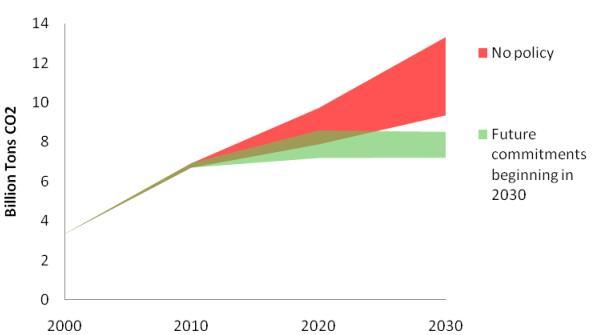On the eve of the UN’s highly-anticipated Copenhagen meeting, international climate policy negotiations remain in gridlock. Many OECD countries insist on binding emissions limits for their economic competitors in the developing world, while countries such as China and India are unwilling to accept such responsibility. They argue that because they are poor, low per-capita emitters and have contributed relatively little to cumulative emissions, they should not be asked to forgo the use of cheap fossil fuels to drive their own industrialisation. Moreover, they point out that since the 1997 agreement in Kyoto, developed countries as a whole have failed to cut emissions and take the first steps indicated by the UN framework.
While the new US and Japanese administrations have renewed hopes that developed economies are now ready to take on serious climate obligations, fears over the economic recovery and the international repercussions of national policies in only a subset of countries might limit their willingness to act. In the US, in particular, politicians are concerned that increases in energy costs at home relative to those abroad would lead to more offshore outsourcing, exacerbating the already-high unemployment rate.
Overlaying the political debate is the physical reality that time is running out. While it may be perfectly reasonable to expect wealthy, industrialised countries to pay a larger share of the global climate protection bill, it has become increasingly clear that, whoever pays for them, reductions in developing countries must begin very soon to keep acceptable climate targets on the table. Dominated by China, this group will be responsible for nearly all growth in global emissions in coming decades in a “no policy” baseline scenario, as demand for cheap coal-based energy expands with economic development. Even if OECD countries were able to take the extraordinary measure of completely eliminating their emissions by 2050, uncontrolled emissions from the remaining countries would be sufficient to push atmospheric concentrations beyond any of the global stabilisation targets currently proposed.
Thus the involvement of countries like China is essential to achieve global carbon reduction goals and to gain the support of OECD countries, but they make a strong case for a free pass. What can be done? In a pair of recently published articles (see Climatic Change Letters, Volume 1), we propose one way forward. The key insight in our analysis is that a commitment now on behalf of China and other key developing countries to accept pre-specified future emission reduction targets could effectively address all three concerns. Parallel studies based on two widely used integrated assessment models of the global economic, energy, and climate systems show that anticipation of a credible future policy target induces a smooth transition, leading to reductions from baseline emissions well before the policy actually begins (Figure 1).
Figure 1. Energy-related CO2 emissions in China under a no-policy reference case and a future commitment scenario
Note that agreeing to future commitments beginning in 2030 leads to reconfiguration of capital stock beginning immediately. The ranges reflect differences between the two models used in the parallel studies.
The primary driver for this result is the long lifetime of capital in the energy system, in particular the longevity of conventional coal-fired electric generation, the main source of emissions in the developing world (now and in an expected “no-policy” future). The most attractive abatement options involve investing instead in low- or zero-carbon generation capacity, including renewable energy sources, nuclear power, advanced coal with carbon capture and storage, and improvements in end-use efficiency. This strategy would optimise the replacement of carbon-intensive capital, whose costs are sunk once the capacity is installed. Equally important, many low-carbon options will require a sustained research and development effort to bring them to market. Thus if a country is eventually to undertake emissions reductions, the sooner its firms and households know about it, the better their investments in both capital and technology.
The parallel studies compared two paths the world might take to achieving a stabilisation goal of limiting the total impact of atmospheric greenhouse gases to the equivalent of a doubling of pre-industrial CO2 (this translates to a roughly 50% chance of keeping the global average temperature increase in 2100 below 2.5 degrees C). In both scenarios, we made what we believe to be realistic assumptions about when developing countries join the effort with legally binding targets, allowing China, for example, to remain out until 2030. In one scenario, we assume that non-participating countries undertake no advance planning prior to joining the coalition, while in the other, expectations of future commitments lead to advanced planning. In this case, we assume that the targets for 2030 and beyond are announced immediately and optimally anticipated. The results are striking. In the no-advanced-planning scenario, developing countries like China are left with stranded assets when their commitment period begins, whereas better investment planning in the “anticipated” scenario dramatically reduces the overall cost of their participation in the global effort, by 20% to 40%.
Meanwhile, because far-sighted investment decisions in developing countries have the collateral benefit of reducing their emissions in the near-term, OECD countries leading the effort today could avoid some of their most costly reductions while keeping the global pathway consistent with the climate stabilisation goal. Both models show that this effect could lead to a cost savings of nearly 50% to the OECD. Moreover, since the anticipatory actions by China and others save money by shifting some costs forward in time in exchange for avoiding high adjustment costs later, the near-term competitiveness gap could shrink considerably. Finally, the notion that credible targets are anticipated by rational agents provides much-needed leverage on the thorny issue of verification. An easy test for the credibility of a Chinese announcement of a future commitment will be whether or not it begins configuring its capital stock accordingly. Although not a perfect solution, firm future commitments by developing countries could reduce the cost of stabilisation for all parties without violating political constraints or compromising reasonable global environmental goals. Such a winning combination could be a breath of fresh air for the climate stalemate.
References
Bosetti, V., C. Carraro and M.Tavoni (2009) "A Chinese commitment to commit: can it break the negotiation stall?", in press Climatic Change Letters
Richels, R.,G. Blanford and T. Rutherford (2009) “International Climate Policy: A “Second Best” Solution for a “Second Best” World?”, in press Climatic Change Letters










